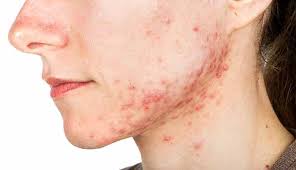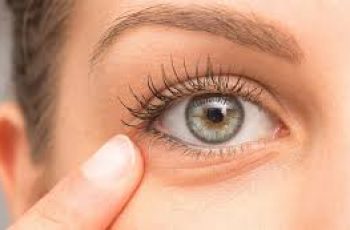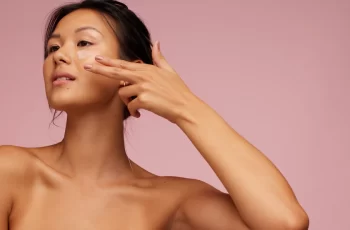Cystic Acne
Why do I get acne cysts?
Cystic acne occurs in men, women and teenagers. It is most often seen as bumps and cysts along the jawline. These cystic pimples are often recurring. Deep cystic acne can occur anywhere on the face such as the chin, cheeks and forehead or on the body such as the chest, scalp, back and buttocks. What causes cystic acne? Is cystic acne hormonal? What are the best treatments for cystic acne? Before we answer these questions, I will explain what cystic acne is.
Remember, it is always best to shop by your Baumann Skin Type when choosing skin care products.
Take the Quiz
What is Cystic Acne?
A true acne cyst is a clogged hair follicle filled with bacteria that has been walled off by the body’s immune system to keep the acne-causing bacteria from spreading. When the body’s natural inflammation cycle occurs, the pore gets clogged. This causes a comedone. The closed pore allows pressure to build up inside the hair follicle, stretching out the hair follicle allowing more room for bacteria, pus, keratin and dead keratinocytes. If untreated, the pressure eventually ruptures the wall of the hair follicle leading to scarring.
What is the white stuff that comes out of a cyst?
Acne cysts are filled with white pus. What is in this white liquid in cysts?
The hair follicle is lined with epidermal cells called keratinocytes. These keratinocytes make a protein called keratin. (This is why they are called keratinocytes.)
The thick white smelly stuff in a cyst is keratin. Keratin is the same protein that makes hair and nails.
How cysts form?
When the pore becomes clogged and a closed comedone forms, there is a build up of debris inside the the hair follicle.
The contents of this debris in an acne cyst are :
Sebum (oil)
Keratin
Dead keratinocytes
Exudate from immune cells we call pus
Acne causing bacteria known as Cutibacterium acnes. (The name was changed from P. acnes to C. acnes)
What Is Cystic Acne?
Cystic acne starts in the hair follicle which opens as a pore on the skin’s surface.
The hair follicles get clogged hair with dead skin cells and keratin which causes comedones. Why do the hair follicles get clogged? Click here to read more about this.
When dead skin cells and oil accumulate in the hair follicle, bacteria is attracted to the hair follicle. This triggers inflammation which brings fluid to the area. Accumulation of the inflammatory fluid, desquamated skin cells, and keratin protein further increase the intrafollicular pressure.
The pressure caused by the build up of dead skin cells, pus, and fluids breaks the wall of the hair follicle, allowing bacteria into the skin. The body recognizes this bacteria as foreign and mounts an immune response. Immune cells surround the bacteria and pus and wall it off to prevent spread of infection to other parts of the body. This leads to a cyst.
If you pick at the acne cyst, it can turn into an epidermal inclusion cyst which must be removed by a small surgical procedure. Scarring can also occur with cystic acne because of damage to the walls of the hair follicle.
What causes cystic acne?
Cystic acne in men and women is caused by a combination of these factors:
Hormones
Lipid composition of sebum
Stress
Debris such as sunscreen and silicones left on the face
Comedogenic skin care ingredients
Altered keratinization and impaired desquamation
Skin microbiome
Insulin like growth factor levels
Sugar in diet
How to Treat Cystic Acne?
Can you cure cystic acne? Yes but the best way to cure cystic acid is to begin a retinoid. You can try a topical one first, but if you have severe cystic acne you should see a dermatologist because you may need a prescription for an oral retinoid.
The best way to treat cystic acne is to get on the right products for your Baumann Skin Type. Let our dermatologists guide you by choosing products based on your Baumann Skin Type.
Vitamins To Use if You Have Cystic Acne
Retinoids are a form of Vitamin A. You can take Vitamin A supplements to treat acne but you must be careful not to take more than 4,000 IU’s per day. Vitamin A is a fat soluble vitamin which means it is toxic when too much is taken. Vitamin A can also cause birth defects if taken while pregnant. It is much safer to see a dermatologist to treat your acne cysts then trying to manage it naturally by yourself. Retinoids are a safe way to treat acne cysts but should be carefully monitored by your doctor with blood test that follow your liver function and triglycerides and cholesterol levels.
Vitamins to Avoid if You Have Cystic Acne
If you have cystic acne, avoid Vitamins B6 and Vitamin B12 because they can cause acne breakouts. These acne cyst causing vitamins are in many body building supplements.
Products to Use and Avoid if You Have Cystic Acne
The best way to avoid getting cystic acne is to avoid using products with comedogenic ingredients. You also need to make sure that when you choose skin care products, you shop by your Baumann Skin Type.
DQH Can I use salicylic acid first and then vitamin C?
It’s easy to create a skincare routine, but knowing how to use it is another thing entirely. In most cases, if you’re not getting the desired skin results, it could be due to the layering of conflicting ingredients. So, is it possible that salicylic acid and vitamin C are such ingredients? Or are these active ingredients the duo that’s been missing from your skincare routine? If you want answers, stick around because today we are going to explain the benefits of salicylic acid and vitamin C and how they can be used in your daily life.
What are the benefits of salicylic acid for skin?
Salicylic acid is one of the most commonly used beta hydroxy acids and is favored by many people with oily, acne-prone skin. This acid is derived from willow bark, and unlike its water-soluble relatives (called alpha-hydroxy acids), salicylic acid is oil-soluble, which means it can penetrate deeper into the lower layers of the skin. Once it reaches the lower layers, it can help unclog pores of excess sebum, dirt, bacteria, debris, and impurities. This results in clearer skin tones and greater definition.
Not only does salicylic acid benefit the underlying layers, but the outer surface of the skin benefits as well. When applied to the skin, salicylic acid removes the buildup of dead skin cells. This is accomplished by breaking the bonds that hold dead cells to the surface. Over time, this can cause the complexion to look dull and prone to acne, blackheads, and other blemishes.
If you’d like to learn more about salicylic acid and how it can improve your skin, check out this dedicated blog post from a beauty insider.
What are the benefits of vitamin C for skin?
Vitamin C is considered one of the most powerful antioxidants, which means it is very effective at fighting free radicals and preventing them from causing further skin damage. Examples of free radicals include pollution, central heating, UV rays and harsh climate. They attack proteins, fats and cell membranes as soon as they come into contact with the skin, causing signs of premature aging such as fine lines and wrinkles as well as hyperpigmentation, flaky patches of skin and loss of elasticity.
Many people usually prefer to use vitamin C in their morning routine as this ingredient gives the complexion a radiant glow. You’ll also find that vitamin C can target areas of hyperpigmentation, plumping the skin and reducing the appearance of fine lines and wrinkles.
The thing about vitamin C is that there are a lot of outdated studies going back to the 1950s that describe vitamin C as an unstable skin component. Thanks to improvements in modern technology, this is no longer the case as all products now contain a stable form of vitamin C.
Visit The Beauty Insider to learn more about vitamin C. So please check out our blog post.
Can I use salicylic acid first and then vitamin C?
Yes, you absolutely can. In fact, it’s thought that using salicylic acid before using vitamin C ensures it penetrates faster and works faster.
This is an efficient way to utilize two power sources, and the reason has to do with pH. For example, the skin’s natural pH is about 4.7, making it slightly acidic. Salicylic acid and vitamin C are also both acidic, and you’ll find that vitamin C is absorbed quickly into the skin. Therefore, using salicylic acid beforehand can increase the acidity of the skin and allow vitamin C to penetrate into the skin faster.
While this is considered an effective way to combine two powerful ingredients, you need to be aware of your skin type and how it reacts to certain active ingredients. Even people with perfect, normal skin can experience skin sensitivity and irritation. Therefore, always consult a doctor or dermatologist before using any new products on your skin.
It’s also important to follow skin application rules. In this case, you need to use the product correctly to ensure you get the best results for your skin. If you’re not sure what I mean, the basic rule for skin is to start with the thinnest consistency and work your way up to the thickest consistency. This prevents a barrier from forming on the surface, preventing other active ingredients from penetrating the skin.
Can I use salicylic acid at night and vitamin C in the morning?
Yes, absolutely, this is considered the most effective way to get returns without any adverse side effects. This is because there is enough time between applications to ensure that the skin’s pH levels return to balance.
You’ll also find that Vitamin C is rich in antioxidants and is perfect for use in the morning to ensure your skin is protected and looking its healthiest. Due to the small size of salicylic acid molecules, it is an acid that is able to reach the deepest parts of the skin. While this is effective at keeping skin clear, it also increases the risk of irritation and photosensitivity. Therefore, many people prefer to use powerful BHAs in their evening routine without exposure to UV rays, pollution, or harsh weather.
Warning: If you avoid using sunscreen every day, none of these ingredients will do what your skin needs. The combination of chemical peels and powerful ingredients increases the risk of further damage to the skin’s surface. Use SPF 50 every day to keep your skin protected and your lipid barrier healthy, even on cloudy days, keeping your skin in top condition.



